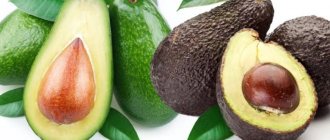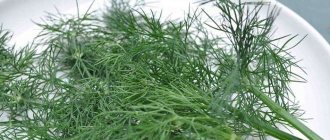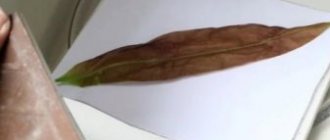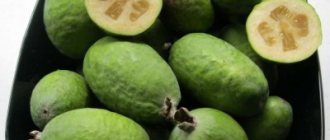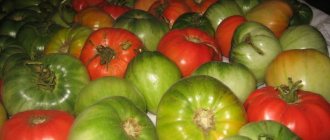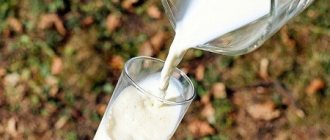Figs are well known to residents of our country, especially to those who often vacation on the Black Sea coast. There are several varieties that differ in color, shape, size, and taste. All of them are stored for a long time in dried form, acquiring a special sweetness, and are suitable for making preserves and jam. It is very difficult to preserve fresh fruits; they quickly undergo a fermentation process, but dried fruits will remain calm for several months.
Selection and preparation of fruits
When choosing quality fig tree fruits, pay attention to their appearance, smell and texture. The surface of the fig should be smooth, the peel clean, without stains or damage. Good fruits have a perfectly round shape. If you notice a sour smell, this indicates that the fruit has begun to ferment and is not edible.
Ripe figs are moderately soft; they do not spread in your hands even when pressed. Small drops of nectar form on the peel of a high-quality fruit.
The color depends on the variety and can be:
- green;
- yellow;
- brown;
- dark purple, almost black.
A spoiled product has a very soft and slippery consistency, and traces of mold are visible at the base of the fruit petiole. The sour smell is characteristic not only of fermented fruits, but also of overripe ones. And figs ripen very quickly - in 2-3 days. Dents appear on the sides, the skin withers and shrinks.
Figs are a seasonal fruit; they are bought from June to October. The peel is edible and does not need to be peeled. The fruits are washed, cut in half and the contents are eaten with a spoon.
The fruits are prepared for storage. First, they are carefully sorted, removing all specimens with traces of mechanical damage and an unpleasant smell of mash. A high-quality product is wiped with a soft cloth to remove excess moisture, especially in the area of the stalk. The figs are then placed in a container, box or bowl in a single layer.
Rules for choosing dried figs
Dried figs are radically different from their fresh counterpart. Ripe berries are purple in color; yellow varieties are less common. After drying, the fruits are beige, gray, or brownish in color. Try to choose nondescript, wrinkled specimens. We pass by a beautiful, smooth, amber-colored fig.
Other selection criteria:
- same size. Responsible producers always perform sorting. Dried products of different sizes differ in humidity, drying speed, you will come across overly dry or wet specimens;
- matte coating. Shiny, smooth skin is a sign of chemical treatment;
- flattened washer shape. Crooked specimens, different thicknesses over the entire surface - a sign of processing of defective figs;
- nice smell. Sweetish aroma without chemical notes.
Dried figs have many beneficial properties. They are the only quality berries. Do not buy dried fruits with stains, dents, or strange colors. There should be no sticky residue or traces of moisture on the surface.
Dried fruits bend when pressed, leaving a small hole. Fig fruits do not crumble and retain their elastic structure.
How to store it correctly
To preserve figs at home for as long as possible, ensure optimal temperature, humidity and lighting conditions.
Temperature
When storing fresh fruits indoors, the temperature is maintained within +18…+20°C. In such conditions, the figs will remain for a day. They will be stored in the refrigerator at a temperature of +1...+2°C for 10 days. Dried figs are stored at +15°C for no longer than 6 months.
Humidity
In dry air, the fruits wither, and in high humidity they rot. The optimal indicator is maintained within 60-75%.
Lighting
A bright lamp or direct sunlight are the enemies of ripe figs, so it is recommended to store them in a dark place (refrigerator, cellar, basement). This applies to both fresh and dried fruits.
Features of storing fresh figs
Ripe fruits are very tender. Therefore, it is recommended to consume them immediately after collection, and this must be done in places of ripening. After transportation, the fruit begins to ferment immediately.
If you want to preserve fresh figs, it is recommended to put them in the refrigerator. The temperature should be +1 degree. In such conditions, fruit can be kept for 2-3 weeks. Berries should be prepared for storage. To do this, it is recommended to do the following:
- wash and dry the fruits;
- place in containers and close;
- place on the vegetable shelf.
It is worth considering that storing figs at room temperature is contraindicated. Within a day the fruits will begin to ferment.
Where to store
Storage of figs depends on its type:
- Fresh fruits or juice are stored in the refrigerator.
- Berries are also frozen at temperatures from -15°C.
- The dried, dried or canned product is kept in the cellar, pantry or on the balcony.
- At room temperature, figs will last no more than a day without refrigeration.
Regardless of the storage location, it is necessary to protect the fruits from bright light and direct sunlight.
Can it be stored in the refrigerator?
The best place to store figs is the refrigerator. The fruits are kept at a temperature of +1°C. Shelf life – 2-3 weeks.
Calorie content of dried figs per 100 g
Drying removes moisture from the product. The concentration of nutrients increases. At the same time, calorie content also increases. The energy value of dried figs is 257 kcal. Particularly sweet, ripe specimens can contain up to 280-290 kcal. The BJU ratio is 3.1/0.8/58, respectively.
Dried figs contain fewer calories due to the increased amount of moisture. Energy value from 170 to 210 kcal. There is only one drawback - short shelf life. Insufficiently dried berries will mold faster. The benefits and harms of dried figs for the body are similar.
The dried product contains a lot of sugar and has a high glycemic index. A healthy treat will become harmful if you are obese or overweight.
Storage methods
There are several basic ways to store fig tree fruits.
Dried
Such figs retain most of their beneficial properties. Dry the fruits in the sun or in an electric dryer.
For processing in the fresh air, carry out the following steps:
- The fruits are washed, dried and placed on a wire rack. Cut in half when drying, place the cut side up.
- The grille is installed so that it is blown by the wind from all sides.
- The figs are wrapped in two loose layers of gauze to protect them from insects and dust.
- Drying lasts 4-6 days.
- Then the fruits are collected on a string and placed in the shade for another day.
An electric dryer makes fig slices juicy and golden brown:
- The fruits are divided into 2 parts and dried in the sun for 8-10 hours.
- Then they are laid out on the device pallet in 1 row.
- Small fruits are dried for 10 hours, large ones require more time, check their readiness.
Dried figs are stored for no longer than six months at a temperature of +15°C.
Quick freezing
To treat yourself to figs at the end of the season, they are frozen. To do this, the fruits are washed, dried, placed in an airtight container or bag and placed in the freezer at a temperature of -15°C.
Important! It is not recommended to wash figs under running water, as this will damage the skin. It is advisable to place the fruits in a large colander or sieve, dip them into a basin several times, and then let the water drain.
Drying
This product contains more moisture than dried product, so it needs special storage conditions. For 3 months, dried figs are kept in a closed glass jar on a cool balcony or in a pantry.
If you put the dried product in canvas bags with drawstrings, the storage period will last up to 6 months. You can wrap the fruits in paper and place them on the bottom shelf of the refrigerator. In this form they will remain for at least 8 months.
Pickling
To marinate the product you will need (for 1 cup of fruit):
- 1 tbsp. port wine;
- 1/4 tbsp. balsamic vinegar;
- 1 tsp. lemon zest;
- 1 tsp. orange zest;
- 1 tsp. Sahara;
- 1/2 tbsp. chopped walnuts.
- salt, pepper - to taste.
Preparation:
- Place the figs in a glass jar, pour in the port wine and add the zest.
- Close the container and put it in the refrigerator for a day.
- After 24 hours, the liquid is drained and the remaining ingredients are added.
- Bring the mixture to a boil, reduce heat and simmer for 30 minutes.
- Cool the figs, transfer them to a jar and put them in the refrigerator.
The pickled product is stored for 3 to 5 months.
Compote
For a 3-liter container, take 300 g of fresh or dried figs and 150 g of sugar. Pour 2.5 liters of water into a saucepan, add figs and sugar and cook for 10 minutes. Remove the pan from the stove, pour into a jar and close with a lid. Store in the refrigerator.
Jam
You will need 0.7 kg of fig fruits and 0.5 kg of sugar. The ingredients are mixed in a basin or pan and left for 3 hours. After the juice is released, place the container on the stove and cook for 5 minutes. The syrup is drained, after which the procedure is repeated again. The jam is poured into jars and closed. You can add citric acid or vanilla to taste.
The jam is stored in the cellar, pantry or refrigerator.
Juice
The juice is useful for diseases of the cardiovascular system, thrombosis, and anemia. Fresh fruits are washed, doused with boiling water and rubbed through a sieve. The puree is mixed with boiled water in a 2:1 ratio. The mixture is squeezed through cheesecloth, and the resulting juice is poured into a jar or bottle. This drink is stored in the refrigerator for 2-3 days.
Useful properties and contraindications for the human body
Dried fig trees contain antioxidants, pectin, vitamins C, K, and other groups. Figs are valued for their high concentration of ficin. An important enzyme for digestion and the establishment of protein metabolism. And it is heat resistant up to 80 degrees.
Routine is present. It helps to absorb vitamin C, increases protective functions, and guards our immunity. The product is rich in chromium, potassium, magnesium, sulfur, zinc.
What else are dried figs good for the human body:
- improves the functioning of the nervous system, improves psycho-emotional state;
- increases potency;
- increases tone, relieves fatigue;
- improves blood composition, fights anemia;
- balances hormonal levels;
- has been used since ancient times as a medicinal product for infertility;
- cleanses the kidneys, the healing product helps remove excess fluid;
- reduces the risk of cancer;
- promotes proper development of the fetus during pregnancy;
- fresh and dried figs increase lactation;
- compacts bone tissue.
Do you dry your figs yourself?
Not really
The main contraindication to consuming dried figs is diabetes. The sweet preparation will cause harm to people with gastritis and pancreatitis. Use with caution if you have gout. Dried delicacies rarely cause an allergic reaction, but individual intolerance has not been canceled.
Dried figs contain vitamins, minerals, energy value 257 kcal. You can cook it in the sun, in an electric dryer, microwave oven, or an air fryer is suitable.
Helpful tips to help keep figs fresh longer
There are several secrets to extend the shelf life of fruit:
- Immediately after arriving home, sort through the purchased or harvested figs, discarding damaged or fermented fruits.
- Wash them not under a running tap, but in a container of water. This will keep the skin intact.
- Do not expose fig trees to light or direct sunlight.
- Do not lay them out in several layers.
How to keep figs fresh during transportation
For transportation, they prefer to take green fruits that have not yet become sweet and soft. They are laid out in a box in a single layer and covered with burlap to protect from dust, insects and light. Leave a distance of 0.5-1 cm between the fruits so that the sides do not wrinkle and the juice does not leak out.
This is interesting:
How much and how often to water figs in summer: instructions for beginners
Simple ways to propagate figs from cuttings at home
Step-by-step instructions on how to properly cover figs for the winter and prepare the tree for cold weather
We take figs with us on the road
It is difficult to overestimate the benefits of figs. It is called a superfruit due to its unique amount of nutrients. It strengthens the cardiovascular and nervous systems. Figs are also very nutritious and can quickly satisfy hunger. If you decide to take fruit on the road:
- Wrap each fruit in a paper towel.
- Place in a plastic food container.
- The fruits should be placed freely, but not roll around the tray.
- Don't cover it with a lid!
It is advisable to transport the fruit in a cooler bag. If you don’t have one, you can freeze water in a bottle and place it near the container.
Figs, both dried and fresh, have laxative properties. It is not recommended to eat it before a long journey.
How to choose the right raw materials
When choosing fresh figs that you plan to dry, you should pay attention to the following criteria:
- The size of the fruit should be about 4-5 cm in diameter. If they are smaller, then it may be a wild fig (it is less sweet); if larger, then the fruit is overripe, its pulp is not so juicy and soft.
- There should be a large number of seeds inside the berry, this indicates its quality and high taste characteristics.
- The color does not matter when choosing, since it directly depends on the variety. High-quality and tasty figs can be brown, blue, black and yellow-green.
- The skin should be matte and slightly dry. A shiny and smooth surface can only be found in fruits that have been treated with preservatives for better transportation.
- A subtle smell of iodine is allowed, since this element is contained in large quantities in the berry. The fruit may produce a mixed aroma of grass and sweetness. There should be no chemical or unnatural odor from the selected figs.
Time of collection or purchase
In one year, a fig tree can bloom 2-3 times.
Figs that are sold and edible grow on a fig tree only once a year - at the end of summer. At this time, the fruits from the female inflorescences of this tree ripen. These are juicy, sweet and healthy berries.
The owner of a fig tree should evaluate the condition of the fruit from time to time. An indicator of their ripeness in August-September is a slight softness and witheredness at the tail. To dry, it is better to keep the figs on the tree a little longer (1-2 weeks), so they will reach their natural condition. You can use a sharp knife or pruning shears to trim fig clusters.
It is necessary to wear gloves when collecting fruits, as their juice can cause burns on your hands.
Which raw materials are not suitable?
Before drying, you should carefully inspect the purchased or harvested crop and reject fruits that have the following defects:
- Sour aroma. It indicates that the fermentation process has begun, which will be followed by rotting and mold formation.
- Excessive softness of the fruit, especially the skin. Such a specimen will most likely turn out to be rotten.
- Excessive hardness. She talks about harvesting too early and the fruit being unripe. These figs will have virtually no sweetness.
- Presence of stains, violations of the integrity of the peel. These are traces of exposure to pests or diseases.
Drying at home and outdoors
The drying process can be carried out in several ways, which will require various kitchen appliances.
In an electric dryer
How to dry figs in a vegetable and fruit dryer:
- Cut the fruits into slices or plates; their thickness should not exceed 2-3 mm.
- Place the raw materials on the pallet in one layer.
- Set the operating temperature of the device in the range of +55 +60 °C.
- Turn on the dryer. Swap the pallets every 3-4 hours, so the raw materials will dry more evenly.
- The total drying time can take from 1 to 2 days, depending on the area of the trays, the number of figs and the power of the device.
In the oven
Whole or chopped figs, either fresh or boiled in sugar syrup, are suitable for this method.
Basic principles for using an oven to dry a fig tree:
- Set the minimum operating temperature of the device. Optimal is +60 °C.
- If the oven settings are not at this temperature, then you should set it to the lowest possible temperature (about 100°C) and turn the raw materials over every 1.5-2 hours.
- If you plan to dry sliced fruits, then the cut should be located at the top and not come into contact with the grate.
- The use of baking trays is not permitted. Air circulation and constant blowing can only be achieved by placing the figs on a grill.
- The oven door should be kept ajar at all times. Otherwise, the figs will bake in their own juices rather than dry out.
- Cooking time can vary from 8 hours to 2 days. You can determine readiness by appearance and consistency.
In the microwave
Instructions for drying fig trees in the microwave:
- Cut the fruits into thin 2-3 mm slices and place them in one layer on a wire rack.
- Turn on the “Defrost” mode and set the timer for half an hour.
- After the timer alerts, check the condition of the raw materials and, if necessary, extend the drying time for another 5-10 minutes.
Outdoors under the sun
This option is used in regions with hot climates with normal or low humidity. Excess moisture in the air prevents drying and provokes rotting and mold formation on raw materials.
How to dry figs outdoors:
- Boil the fruits in sugar syrup. In this method, boiling is a must; this way the taste of the fruit is better preserved and the likelihood of spoilage of overripe specimens is reduced.
- Prepare a large wire rack and place the boiled and dried figs on it. They should not touch each other.
- Place in the sun and cover with gauze to prevent damage to the raw material by flies and other insects.
- Turn the figs once a day. Bring the grill indoors at night or during bad weather.
- The total drying time outdoors is 2 to 3 days.
Drying in the sun
First, you need to wash and dry the figs, and then put them on a wire rack. It will need to be installed in such a way that air can enter from all sides.
This drying will last from four to six days. After this, the berries can be dried in the shade. To do this, the fruits need to be tied to a strong thread.
In order to speed up the drying of figs, they must be cut into two parts and placed on a wire rack.
Please note: the sweet smell of these berries is a bait for various insects. Therefore, the fruits that you put on the grill will need to be covered with gauze cloth.
How to tell if figs have gone bad
You can determine the depravity of a fig tree by the following signs:
- Formation of mold on the surface.
- Pungent sour smell.
- Rancid taste.
- Dampening of dried fruits. The consistency becomes too soft and watery.
- Drying of dried fruits. They become excessively hard and crumble.
- The surface is covered with unpleasant mucus, and mold spots are visible near the stalk.
- Dents. Relevant for fresh products. Indicates non-compliance with transportation conditions.
Spoiled figs should not be eaten . It develops bacteria and fungi that can cause poisoning or gastrointestinal upset. If signs of deterioration appear, the product should be discarded. You can try to moisten dried figs by wrapping them in a damp towel, and dry damp figs in an oven or electric dryer.
